Institut Charles Sadron PECMAT
Research
The scientific activities carried out within the PECMAT group are centered around the following five main research axes:
Axis 1: New concepts in chemistry through molecular, supramolecular and macromolecular engineering at interfaces
Axis 2: Multimaterials and anisotropic materials
Axis 3: Polyelectrolytes complexes, structures and dynamics
Axis 4: Dynamics of Self-Assembling Copolymers
Axis 5: New functional carbon nanotube building blocks
Axis 1: New concepts in chemistry through molecular, supramolecular and macromolecular engineering at interfaces
Nowadays, bottom-up processes of organized matter in order to design microstructured surfaces and nanoarchitectured organizations are a well-established way finding an increasing number of applications in various areas. To go one step further in this field, we are developing original strategies to modify the surface of different kind of substrates (planar surfaces, electrodes, elastomers, porous materials) in order to establish new concepts in biosensing, catalysis, smart materials design (mechanoresponsive) and in biomaterials.
Four aspects are developed:
(i) Electrotriggered self-construction of polymeric films.
The concept of morphogenic self-construction of films whose buildup is triggered by the presence of a molecule, which plays the role of the morphogens, is currently enriched. Our goal here is to develop new chemical tools allowing generating microstructured polymeric films exclusively at a surface by using electrochemistry. The obtained microstructures should be totally new related to morphogenic gradients used.
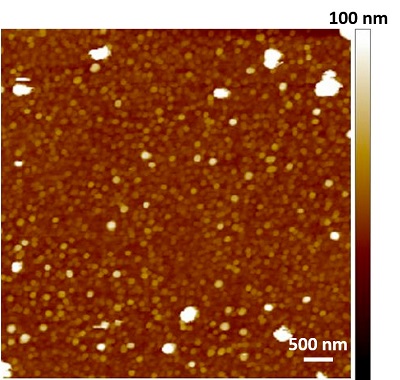
(ii) Autonomous localized catalytically assisted self-assembly and spatially resolved hydrogel.
Another strategy, closer to biology, consisting in using Enzyme Assisted Self-Assembly (EASA), is developed to self-organize fibers growing exclusively from and near the surface and resulting. This stimuli-free concept is based on using enzymes (the “reaction motor”) confined into a nanometric film covered by a seed layer.
Contact : Loïc Jierry
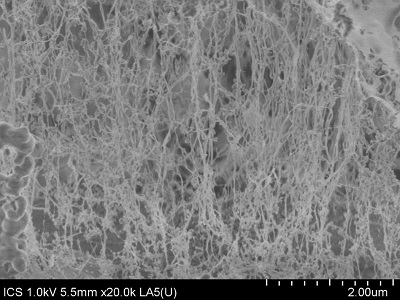
(iii) Soft-mechanochemistry.
In nature, forces induce conformational changes of proteins leading to exhibition or modification of the activity of their activity or property, transducing a mechanical signal into a chemical one. Our goal is to develop chemomechano-responsive systems that allow triggering or controlling chemical processes by macromolecular conformational changes induced by mechanical forces. For this purpose, responsive macromolecules are synthesized to develop materials with cryptic site macromolecules and artificial enzymes whose catalytic activity can be tuned (on/off) when stretched.
Contact : Loïc Jierry
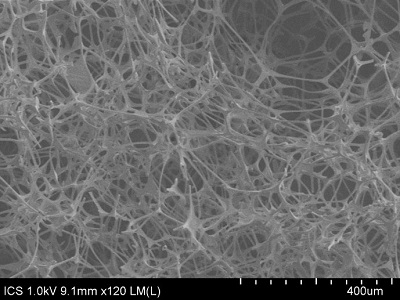
(iv) Biomaterials: the chemistry-biology interface.
Part of our research, in collaboration with UMR 1121 INSERM, UMR 7199 CNRS and EA4691 CNRS, is dedicated to the development of polyelectrolyte-based coatings or architectures for the development of antibacterial coatings and anti-inflammatory. In the field of biomaterials, one of the challenges when implanting an implant is to avoid bacterial contamination that can cause sepsis to the patient. For this purpose, we develop non-stick coatings against bacteria but also bactericidal.
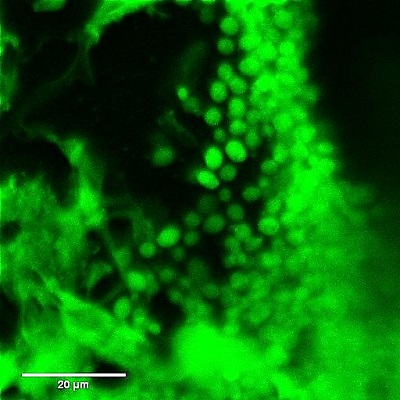
Axis 2: Multimaterials and anisotropic materials
Inspired by nature and based on our longstanding expertise in Layer-by-Layer (LbL) assembled films and our recent breakthrough in creating films with large area in-plane anisotropies, we focus on multi-nano-materials and anisotropic materials. We prepare, study and optimize different multicomposite architectures with respect to their composition, their nanoscale architecture (in-plane and out-of-plane spacing, orientation, etc…) and their anisotropic materials properties. In particular, we focus on optical or electronic properties of metallic (Au, Ag) or semi-conducting (ZnO, TiO2) nano-objects and mechanical properties of nanocelluloses and mineral platelets. For all these hybrid systems, we investigate the tight relationship between the architecture of the assembly (in particular the in-plane anisotropy of 1D-nano-objects induced by grazing incidence spraying) and the resulting properties. The stepwise build-up of complex structures (e.g. chiral thin films made of non-chiral 1D-nano-objects) obtained by the combination of various bottom-approaches allows to characterize the properties as we go from the nano to the mesoscale and to some extend to the macroscopic scale.
Contact: Gero Decher, Olivier Félix, David Martel, Matthias Pauly
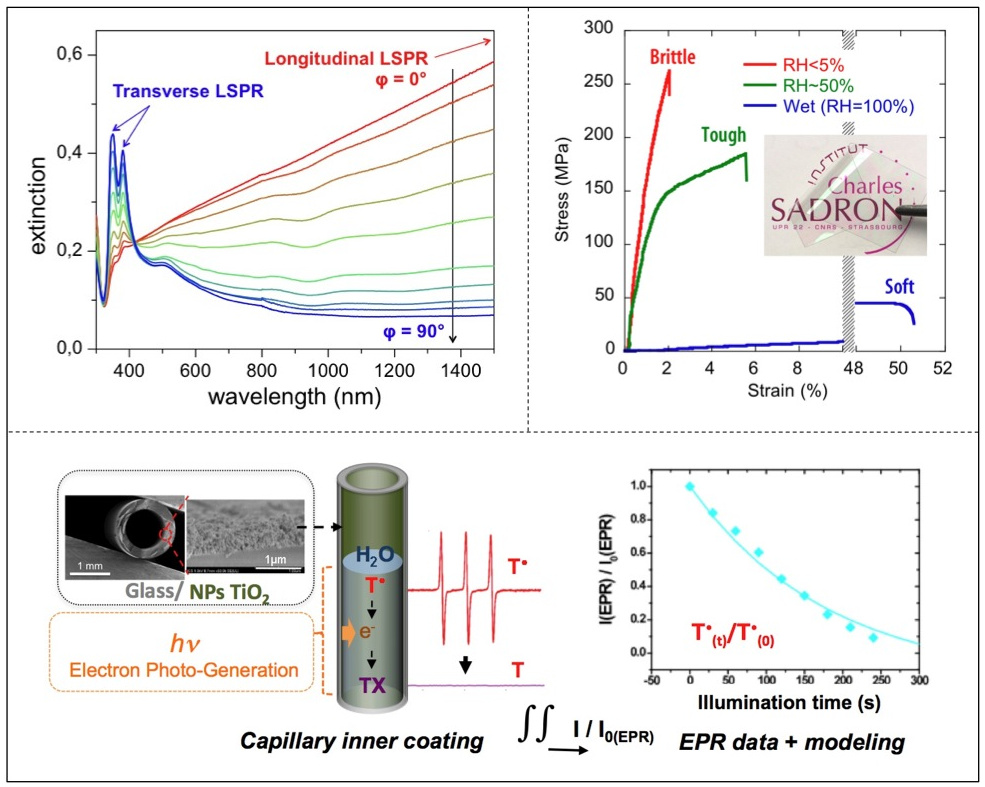
Axis 3: Polyelectrolytes complexes, structures and dynamics
Structure and dynamics of polyelectrolyte - oppositely charged surfactant complexes. This work is a continuation of previous studies on associations between polyelectrolytes and oppositely charged surfactants in aqueous solutions. We are interested in the multi-scale characterization of static and dynamic properties of model systems using macroions of distinct flexibility.
Contact: Jérôme Combet
Axis 4: Dynamics of Self-Assembling Copolymers
This axis includes two research themes:
(i) Kinetics of copolymer micellization.
After a temperature jump in a selective solvent of one of the blocks, both the incorporation of unimers into the micelles and the equilibration of the micelle size distribution can take several days and the characteristic time exhibit time constants depend strongly on the distance from the critical micellar temperature. These phenomena are not well characterized and understood. We use static and dynamic light scattering techniques to follow these kinetics of micellization by using original automated data acquisition and treatment.
(ii) Copolymers at a liquid-liquid interface.
Kinetically frozen particles can be formed by evaporating the solvent from an oil in water emulsion. Recently we proposed a new mechanism for this process. It involves a fast spontaneous emulsification in parallel with a slower enrichment of the interface by copolymer diffusion. These competing kinetics tune the morphology of the nanoparticles. Understanding the underlying phenomena, we can design a variety of morphologies and functionalizations with potential interest for various applications.
Contact: François Schosseler
Axis 5: New functional carbon nanotube building blocks
We study the relevance of double-walled carbon nanotubes (DWNT) functionalized with photo-active pi-conjugated macromolecules to develop innovative hybrid nanostructures. The approach aims to combine in a synergetic manner the remarkable properties of carbon nanotubes (mainly electrical and thermal transport) to the optical characteristics of piconjugated polymers which will be synthesized and covalently bonded to the sacrificial outer layer of DWNT while the inner layer and its properties will be fully preserved. The photo-induced transfer between the nanotubes and the pi-conjugated systems will be evidenced by spectroscopic studies.